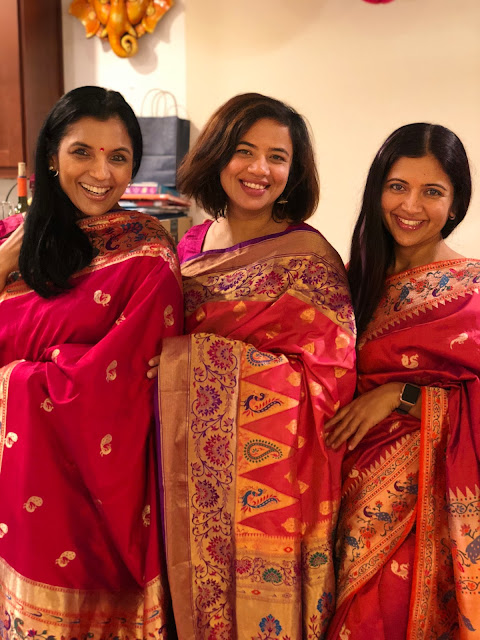The exquisite Paithani saree that I am wearing along with my sister is a super special gift from my sister and is of course, very close to my heart for 2 reasons:
1. It is a gift from the person I love the most.
2. It is one of the richest sarees (Read: a treasure) that has been added to my collection.
We had so much fun posing for the pictures. 3 of us were clad in our ornate Paithanis bought together in one go from the same source.
Now more about Paithani saree. Paithani Sarees are considered to be the richest sarees ever made in Indian history, made in the small town Paithan in Maharashtra are the most exquisite and finest silk sarees in the country today. An art form that has been prevalent from over 2000 years, the origin of Paithani silk sarees is traced back to 200BC in the Satvahana era in the city of Pratishthan by river Godavari and since then has impressed first the Peshwas then the Mughals and the Nizams of Hyderabad who were motivated to not just patronize these silk sarees from Paithan but introduce many new motifs and patterns which went on to become famous designs seen in the best of paithani sarees collection today. Authentic handloom paithani sarees comprise of signature peacock designed ornamental zari pallu and oblique square designed border in real gold and silver threads and make a beautiful piece of art. It is a must-have in the trousseau of every Indian woman,
Paithani is a variety of sari, named after the Paithan town in Aurangabad Maharashtra state where they are woven by hand. Made from very fine silk, it is considered as one of the richest saris in India.
Paithani is characterised by borders and a pallu with a peacock design. Plain as well as spotted designs are available. Among other varieties, single coloured and shot-coloured designs are also popular. The shot colour effect is achieved by using colour color for weaving lengthwise and another for weaving widthwise.
A pattan (Paithani) is a gold and silk sari. Paithani has evolved from a cotton base to a silk base. Earlier, silk was used in weft designs and in the borders, whereas cotton was used in the body of the fabric. Present day Paithani has no trace of cotton. There was a time when silk was imported from China. Now Yeola and Paithan buy silk from Bangalore.
Paithani is a sari made of silk and zari. It is a plain weave, with weft figuring designs according to the principles of tapestry. Traditionally, Paithanis had a coloured, cotton muslin field that often contained considerable supplementary zari patterning. However, in the 19th century, silk fields were also woven.
Due to proximity to the Ajanta caves, the influence of the Buddhist paintings can be seen in the woven Paithani motifs:
- The Kamal or lotus flower on which Buddha sits or stands
- The Hans motif
- The Ashraffi motif
- The Asawalli (flowering vines), became very popular during the Peshwa's period
- The morbangdi, peacock in bangle
- The Tota-Maina
- The Humarparinda, peasant bird
- The Amar Vell
- The Narali motif, very common
Small motifs like circles, stars, kuyri, rui phool, kalas pakhhli, chandrakor, clusters of 3 leaves, were very common for the body of the sari.
Pallu
- Muniya, a kind of parrot used in borders and always found in green colour with an occasional red touch at the mouth
- Panja, a geometrical flower-like motif, most often outlined in red
- Barwa, 12 strands of a ladder; 3 strands on each side
- Laher, design is done in the centre to strengthen the zari
- Muthada, a geometrical design
- Asawali, a flower pot with a flowering plant
- Mor, a peacock
Traditional colours
The dominant traditional colours of vegetable dyes included:
- Pophali - yellow
- Red
- Lavender
- Purple
- Neeligunji - sky blue
- Magenta
- Motiya - peach pink
- Brinjal - purple
- Pearl pink
- Peacock - blue/green
- Yellowish green
- Kusumbi - violet red
- Pasila - red and green
- Gujri - black and white
- Mirani - black and red
In the days of Peshwas, the borders and the pallu were made of pure gold mixed with copper to give it strength. The proportion was 1 kg of gold to 1 tola of copper. The combination was spun into a fine wire called the zari. In recent times, zari is made of silver, coated with gold plating. The borders are created with interlocked weft technique either with coloured silk or zari. In the border woven with a zari, ground coloured silk patterns are added as supplementary weft inlay against the zari usually in the form of flower or a creeping vine.
Two types of border are the Narali and the Pankhi.
Even if a very good weaver has woven the main body, a master weaver is needed for the intricate inlay border paths. The borders and the pallu are woven in zari regardless of the colour of the sari.
- Morbangadi : The word bangadi means bangle and mor means peacock. So morbangadi means a peacock in a bangle or in a bangle shape. The motif is woven onto the pallu, the design sometimes having a single dancing peacock. The saris using this motif are very expensive because of the design.
- Munia brocade: Munia means parrot. Parrots are woven on the pallu as well as in border. Parrots are always in leaf green colour. The parrots in silk are also called tota-maina.
- Lotus brocade: lotus motifs are used in pallu and sometimes on the border. The lotus motif consists of 7-8 colours.





































No comments:
Post a Comment